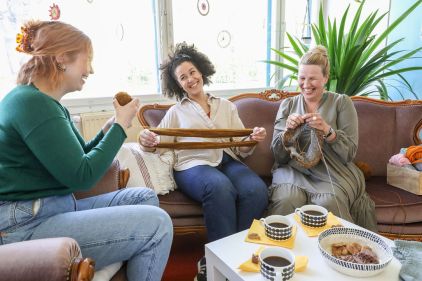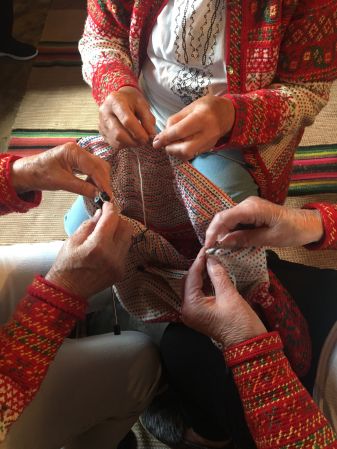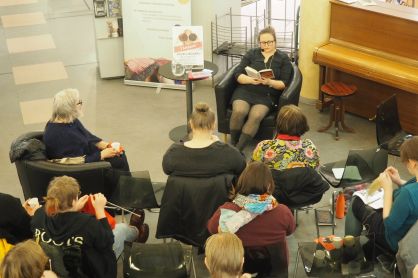Knitting
| Knitting | ||||
|---|---|---|---|---|
| In the national inventory | ||||
|
[[Luokka:• Crafts]]

Practitioners and people who know the tradition well
Knitting is a textile manufacturing technique in which the material used is yarn, and the tools used are knitting needles when knitting by hand or knitting machines when knitting by machine. When knitting, loops are created that interlock with each other. These loops form a flat loop structure, known as "neulos" or knitted fabric. The process of creating a knitted item is called "neulominen." In some Western dialects, the term "kutominen" is used with the same meaning as neulominen. A work in progress, which is still being knitted, is referred to as a "neuletyö," and "kudin" or "kutimet" also mean an ongoing knitting project. A finished textile item produced by knitting is called a "neule."
Knitting is taught at school in textile work, as part of handicraft education and providing a foundation for continuing the hobby later on. According to a survey conducted by the Crafts Union in 2021, knitting is the most popular handicraft hobby in Finland. Its popularity has increased over the past three years, with 26% of respondents now reporting that they knit weekly, compared to 22% in 2018. Knitting has also provided an opportunity to challenge gendered practices, and more men have taken up knitting. Traditionally, knitting has been a part of various social gatherings, including visits to friends, sewing circles, traveling, and tending to animals. Nowadays, people also gather in cafes and other public places to knit. In cinemas, viewers are allowed to knit during movie screenings. In church congregations, services are held where participants can engage in worship activities while also doing crafts like knitting. Throughout Finland, church communities have taken up knitting "comfort shawls" for those who have experienced loss, and this has led to the establishment of Facebook groups like "Lohtuhuivien lähettiläät" (Comfort Shawl Ambassadors). Studies show that knitting helps reduce stress, improves focus, and enhances motor skills. Additionally, knitting as a hobby offers opportunities to meet new people in various knitting communities, such as in libraries and open knitting meetings at yarn shops. Public libraries also organize "Novellikoukku" (Short Story Hook) events, combining storytelling and knitting. According to a visitor survey conducted at Novellikoukku events, these gatherings enable people to connect with others and provide meaningful communal experiences. Knitting together in the same space has been seen as inherently communal, without any particular pressure to interact with others, which some respondents found particularly important, especially if social interaction otherwise felt challenging. In these cases, communal knitting was considered socially therapeutic. In addition to in-person knitting meetups, the communal aspect of knitting thrives on social media. People share information and showcase their knitting hobbies in various Facebook knitting groups, on Instagram, TikTok, Pinterest, Ravelry, crafting blogs, and crafting podcasts. One notable phenomenon is the "knit along" or "KAL" on Instagram and YouTube, where participants easily join by adding the hashtag #kal to their posts. In KALs, knitters work on the same pattern simultaneously, sharing progress photos, commenting, exchanging experiences, and getting inspired by each other's knitting projects. KALs may attract hundreds or even thousands of knitters from around the world. Additionally, knitters can gather on Discord, where they meet via video calls to knit and chat.

Practising of the tradition
In Europe, knitting initially produced expensive luxury items made from silk and linen yarns. Conversely, in Finland, knitting patterns were more folk-oriented, even though their models were expensive and luxurious imported knits from Europe. In Finland, knitting has been a skill of the people since the 1700s. Materials included yarn spun from their own sheep, dyed with natural and plant-based colors. Knitting is an easy and fast technique, making it a common way to create clothing and other textile items.
Climate greatly influences what and from which yarns knitting is done. For example, in Finland, Sweden, Norway, and Iceland, thick knits and mittens are knitted, suitable for cooler climates. Conversely, in Denmark's milder climate, fingerless gloves are more practical than mittens. Nowadays, knitting patterns are shared in global knitting communities, and influences come from various parts of the world. The knitting yarn market is also global. The knitted fabric is formed from loops knitted in horizontal layers. When knitting by hand, two or five needles, or circular needles, are usually used. Two needles create a flat surface, while five needles or circular needles can be used to create closed circular knitting. By increasing and decreasing stitches, various shapes and fitted accessories, garments, and textiles can be made. Different knitting patterns are created by alternating between knitting and purling stitches. Various knitting patterns can also be achieved through slip stitches and twists. Using different-colored yarns creates multicolored knitting patterns using fair isle and intarsia techniques. Knitting machines, knitting frames, and various knitting looms are also used to make knits. Knits can be made from ready-made kit patterns or by designing them yourself.
Knits are made for personal use and are given to both close acquaintances and strangers in need. Nowadays, knitting is also done for pets. Knitting skills are no longer a necessity for households, but many people still knit. Automated knitting skills, where repeating movements no longer require conscious observation and thought, bring joy. Knitting relaxes, refreshes, provides a sense of accomplishment, offers an opportunity for recovery and empowerment. Knitting can also serve as a tool for releasing negative emotions and for facing and processing difficult feelings. Knitting provides an opportunity to develop cognitive and physical skills. Designing a knit requires understanding three-dimensionality, calculating and fitting gauge into knitting patterns, as well as decreasing and increasing in knitting designs. A knitting project requiring concentration helps shift one's thoughts away from anxiety or sorrow in a tangible way. Knitting also offers a means to address the environment and engage in public and political discourse through craftivism or knitivism. Giving knitted items to charity at home or abroad is a natural, concrete way to help those in need.
The background and history of the tradition
The modern-day knitter finds it fascinating to consider themselves as one stitch in a chain that began long ago. The exact origins of knitting are not known, but there are indications of this early technique dating back to at least the first decades of the Common Era. It is likely that knitting developed independently in various parts of the world. Techniques such as needle binding, knitting, and crochet are all fiber arts, with needle binding being the oldest and crochet being the youngest. The dating of these techniques is made difficult by the fact that museum collections and cataloging may have confused them. Techniques using needles, pins, or hooks have become intertwined, and their classification into different types has been done retrospectively.
The earliest stages of Finnish knitting history are traced back to the Naantali Convent in the 15th century. However, the earliest written mention is somewhat uncertain in whether it refers to needle binding or knitting. Nonetheless, a fragment of knitted textile dating from the late 14th to early 15th centuries has been found in Turku. Thus, knitting has been known in Finland since at least the 1400s. The earliest knits were luxury items, and their influence can be seen in folk knits as well. In Varsinais-Suomi (Southwestern Finland), socks were knitted for sale in Turku and Stockholm from the 17th to the 19th century. Knitting became more common among the Finnish population during the 18th and 19th centuries, and authorities also sought to promote it. In Ostrobothnia, 18th-century estate inventories mention knitted shirts, headgear, socks, and garters. The spread of knitting skills is evident in mentions of gloves and socks. Knitting was often done alongside other work, such as while tending to animals. Idleness was not viewed favorably, and many people enjoyed knitting.
Traditionally, knitting was learned at home, but knitting and crochet have been part of the curriculum in Finnish schools since the establishment of national schools in the 1850s. The making of knitted garments and accessories was a necessity for many families even into the 20th century. Later, it became a luxury for many, offering the opportunity to focus on one's thoughts, relax, and create something personal.
The transmission of the tradition
Traditionally, knitting skills and patterns have been passed down from one household to another and from older generations to younger ones. The teaching of knitting has deep-rooted traditions in schools, and the knitting tradition continues to be passed on and renewed through education. The art of knitting is taught in various educational institutions, including primary schools, basic art education, adult education, and through both in-person and online courses, as well as among hobbyists. Knowledge doesn't always flow only from more experienced knitters to novices. The endless possibilities of the technique ensure that even experienced knitters can always learn something new, and sometimes, a less experienced knitter can serve as a teacher for a specific skill. The knitting tradition also thrives and evolves on social media platforms such as Facebook knitting groups, Instagram, TikTok, and Pinterest.
The significance of YouTube in transmitting knitting skills has grown in recent years. In particular, beginner knitters appreciate the opportunity to repeatedly watch video tutorials to learn challenging aspects of knitting. Many knitters upload videos to YouTube to share their expertise, tips, and instructions with others.
Safeguarding tradition
Knitting is a particularly lively tradition in Finland, and it faces no immediate threats. Knitting can be done very simply, using just the knit stitch, and it requires only a few tools. Incomplete lightweight knitting projects are easy to carry along to lectures, trips, and meetings. It is common and acceptable to knit in public places in Finland. In the past, knitting was both a mandatory and essential skill used for clothing the family and earning additional income. Today, knitting can be either a job or a hobby. Relaxation, joy, and a sense of well-being are the primary reasons for modern knitters to engage in crafting. Knitting helps individuals cope with difficult life situations, regulates blood pressure and heart rate, and has a calming effect. The rhythmic movement of knitting and crocheting is particularly significant, challenging and relaxing the brain. From the perspective of these researched health benefits, knitting is likely to remain popular, offering challenges to the knitter and bringing great joy to both the maker and the user of the finished item.
Recording and digitizing patterns (e.g., Ravelry), instructional videos, social media, and various hobby activities promote the spread of knowledge and skills, thereby ensuring the preservation of this craft. In addition to these, education passes knowledge and skills forward. A potential threat is that vocational education could face cuts during economic austerity measures.
Inexpensive mass-produced products, although well-made, may affect people's interest in making their own knitted items, as yarns can be quite expensive. On the other hand, awareness and concern about the origin and production chain of products can motivate people to make their own clothes. An unstable global situation (wars, natural disasters) can disrupt the availability of yarn and tools, but it can also inspire people even more, as the popularity of crafts tends to grow during difficult times. For example, knitting saw a significant increase in popularity in Finland during the COVID-19 pandemic.
Sustainable development and the demand for eco-friendly materials, tools, and supplies will likely influence material choices and knitting patterns in the future. In the future, considering the life cycle of a knitted item will be an increasingly important factor affecting choices.
Climate change may also affect what is knitted, the materials used, and the thickness of the yarns.
The future of the tradition
The future of knitting looks promising, as it's a multi-generational hobby. There are many young people and young adults enthusiastic about knitting, both in citizen's college courses and craft associations, as well as in basic art education classes, where they deepen their knitting skills further. A knitter never knows everything, as the field of knitting is infinite, and there's always something new to learn. Even today, adults coming to knitting courses generally have a certain level of basic skills, as knitting used to be taught in schools for everyone. However, in the future, the situation will likely be different, as knitting is no longer mentioned in the national curriculum for basic schools. Nevertheless, the ease, prevalence, visibility, and popularity of the craft are likely to ensure a continued interest in knitting. The act of creating and the value of handmade items are on the rise, and there's a growing appreciation for craft skills.
Social media and the internet, in general, lower the threshold for newcomers to pick up knitting needles because the web is brimming with ideas, knitting patterns, technique tips, and instructional videos. Popular platforms like Ravelry, YouTube, and Pinterest are likely the most well-liked sources of information. The internet is a natural platform for getting excited about new things, acquiring information, learning, and studying. Many people have been drawn into knitting as a hobby through the internet. For those living in smaller towns or otherwise lacking local knitting groups, the internet offers the possibility of becoming part of both the Finnish and international knitting communities. Online offerings are constantly evolving, allowing you to discover new knitting trends and explore old, traditional patterns. In a more traditional sense, the availability of knitting books and magazines contributes to knitting enthusiasm. Social media and print media are interconnected, as readers of knitting magazines often post pictures of knitted items made according to the magazine's patterns on the magazine's social media platforms. Similarly, many knitting designers who gained popularity online have since published knitting books. Featuring designers brings a new, modern, and interesting dimension to knitting. Designers have their own following who eagerly await the release of new patterns. The wide variety of knitting yarns also adds to the popularity of knitting. Nowadays, there is an enormous selection of materials and qualities, so everyone can find their favorite yarn. Yarn shops are available both as physical stores and online. Local production is appreciated, and ecological concerns influence many people's purchasing decisions regarding the origin of materials, production conditions, and transportation distances. Many knitters prefer small spinning mills and dyeing workshops, which have sprung up in Finland in recent years.

Knitting today is not just a technical performance; it's a phenomenon with all its dimensions. Becoming part of it attracts many people and makes the hobby versatile.
The community/communities behind this submission
Helsingin kaupunginkirjasto
Kansalaisopistojen liitto KoL ry,
Käsi- ja taideteollisuusliitto Taito ry
Käsityökulttuurin tutkija Marketta Luutonen
Bibliography and links to external sources of information
Videos
Podacasts
Craftstories https://craftstories.fi/
Practitioner's web pages
Craftstories: kerrotaan yhdessä käsityötaidon historia näkyväksi
Publications
Marketta Luutonen, Anna-Maija Bäckman ja Gunnar Bäckman. 2016. Lankapaitoja ja muita asusteita. Helsinki: Maahenki.
Kouhia, A. (2020). The Knitted Fabric of Finland: Contemporary Handcrafted Wooly Socks Depicting the Nation State. TEXTILE 18 (2), 180–202.
Myllys, R. (2922). Silmukoihin kudottu hengellisyys. Käsitöiden tekeminen suomalaisten naisten uskontona. Väitöskirja. Helsingin yliopisto.
Punomo – käsityö verkossa, Neulonta
Rauhala, A. (2019). Neulonnan taito. Helsinki: Suomen muinaismuistoyhdistys.
Taito (2021). Tutkimustulos kertoo käsityöharrastuksen suursuosiosta: lähes puolet suomalaisista harrastaa käsitöitä, nikkarointia tai rakentelua säännöllisesti. Taitoliitto.
Gretel Dahlberg 1987, Korsnäs hembygdsförening r.f.: Korsnäströjor förr och nu Korsnäs Hembygdsförening r.f.
